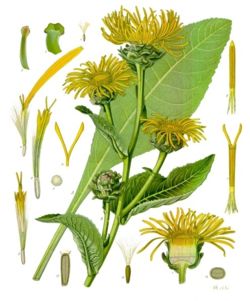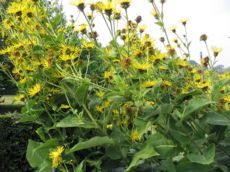Elecampane: Difference between revisions
No edit summary |
No edit summary |
||
| Line 1: | Line 1: | ||
{{SPlantbox | |||
|Temp Metric=°F | |||
|jumpin=If this plant info box on watering; zones; height; etc. is mostly empty you can click on the edit tab and fill in the blanks! | |||
|image=Upload.png | |||
|image_width=240 | |||
}} | |||
{{Inc| | |||
Inula helenium, Linn. Elecampane. Fig. 1959. Tall, thick-stemmed: lvs. unequally dentate-serrate; root- lvs. elliptic-oblong, narrowed into a petiole; st.-lvs. half-clasping, cordate-oblong: outer involucral parts leafy, ovate. Wet, sandy and mountainous regions. Eu., N. Asia. Naturalized in Amer. — The roots are thick and carrot-like. For medicinal purposes, 2-year- old roots should be dug in Aug. lf older, they are likely to be stringy and woody. | |||
}} | |||
{{Taxobox | color = lightgreen | {{Taxobox | color = lightgreen | ||
| name = Elecampane | | name = Elecampane | ||
Revision as of 07:16, 15 March 2010
| subsp. var. | ||||||||||||||||||||||||||||||||||||||||||||||||||||||||
|---|---|---|---|---|---|---|---|---|---|---|---|---|---|---|---|---|---|---|---|---|---|---|---|---|---|---|---|---|---|---|---|---|---|---|---|---|---|---|---|---|---|---|---|---|---|---|---|---|---|---|---|---|---|---|---|---|

|
|
| ||||||||||||||||||||||||||||||||||||||||||||||||||||||
| ||||||||||||||||||||||||||||||||||||||||||||||||||||||||
| Standard Cyclopedia of Horticulture |
|---|
|
Inula helenium, Linn. Elecampane. Fig. 1959. Tall, thick-stemmed: lvs. unequally dentate-serrate; root- lvs. elliptic-oblong, narrowed into a petiole; st.-lvs. half-clasping, cordate-oblong: outer involucral parts leafy, ovate. Wet, sandy and mountainous regions. Eu., N. Asia. Naturalized in Amer. — The roots are thick and carrot-like. For medicinal purposes, 2-year- old roots should be dug in Aug. lf older, they are likely to be stringy and woody.
|
| Elecampane {{{status}}} Fossil range: {{{fossil_range}}}
| ||||||||||||||||||||||||||||||||||||||||||||||||||||||||||||||||||
|---|---|---|---|---|---|---|---|---|---|---|---|---|---|---|---|---|---|---|---|---|---|---|---|---|---|---|---|---|---|---|---|---|---|---|---|---|---|---|---|---|---|---|---|---|---|---|---|---|---|---|---|---|---|---|---|---|---|---|---|---|---|---|---|---|---|---|
 | ||||||||||||||||||||||||||||||||||||||||||||||||||||||||||||||||||
| Plant Info | ||||||||||||||||||||||||||||||||||||||||||||||||||||||||||||||||||
| ||||||||||||||||||||||||||||||||||||||||||||||||||||||||||||||||||
| Scientific classification | ||||||||||||||||||||||||||||||||||||||||||||||||||||||||||||||||||
| ||||||||||||||||||||||||||||||||||||||||||||||||||||||||||||||||||
| [[{{{diversity_link}}}|Diversity]] | ||||||||||||||||||||||||||||||||||||||||||||||||||||||||||||||||||
| {{{diversity}}} | ||||||||||||||||||||||||||||||||||||||||||||||||||||||||||||||||||
| Binomial name | ||||||||||||||||||||||||||||||||||||||||||||||||||||||||||||||||||
| Inula helenium | ||||||||||||||||||||||||||||||||||||||||||||||||||||||||||||||||||
| Trinomial name | ||||||||||||||||||||||||||||||||||||||||||||||||||||||||||||||||||
| {{{trinomial}}} | ||||||||||||||||||||||||||||||||||||||||||||||||||||||||||||||||||
| Type Species | ||||||||||||||||||||||||||||||||||||||||||||||||||||||||||||||||||
| {{{type_species}}} | ||||||||||||||||||||||||||||||||||||||||||||||||||||||||||||||||||
| {{{subdivision_ranks}}} | ||||||||||||||||||||||||||||||||||||||||||||||||||||||||||||||||||
| [[Image:{{{range_map}}}|{{{range_map_width}}}|]] | ||||||||||||||||||||||||||||||||||||||||||||||||||||||||||||||||||
| Synonyms | ||||||||||||||||||||||||||||||||||||||||||||||||||||||||||||||||||
| {{{synonyms}}} |
Elecampane, also called Horse-heal (Inula helenium) or Marchalan (in Welsh), is a perennial composite plant common in many parts of Great Britain, and ranges throughout central and Southern Europe, and in Asia as far eastwards as the Himalayas.
It is a rather rigid herb, the stem of which attains a height of from 3 to 5 feet; the leaves are large and toothed, the lower ones stalked, the rest embracing the stem; the flowers are yellow, 2 inches broad, and have many rays, each three-notched at the extremity. The root is thick, branching and mucilaginous, and has a warm, bitter taste and a camphoraceous odor.

For medicinal purposes it should be procured from plants not more than two or three years old. Besides inulin, C12H20O10, a body isomeric with starch, the root contains helenin, C6H8O, a stearoptene, which may be prepared in white acicular crystals, insoluble in water, but freely soluble in alcohol. When freed from the accompanying inula-camphor by repeated crystallization from alcohol, helenin melts at 110° C. By the ancients the root was employed both as a medicine and as a condiment, and in England it was formerly in great repute as an aromatic tonic and stimulant of the secretory organs. As a drug, however, the root is now seldom resorted to except in veterinary practice, though it is undoubtedly possessed of antiseptic properties.
In France and Switzerland it is used in the manufacture of absinthe.
Folklore
The plant's specific name, helenium, derives from Helen of Troy; elecampane is said to have sprung up from where her tears fell. It was sacred to the ancient Celts, and once had the name "elfwort".[1]
Herbalism
John Gerard recommended elecampane for "the shortness of breath"; today herbalists prescribe it as an expectorant and for water retention; it also is claimed to have antiseptic properties. It has minor applications as a tonic and to bring on menstruation.[2]